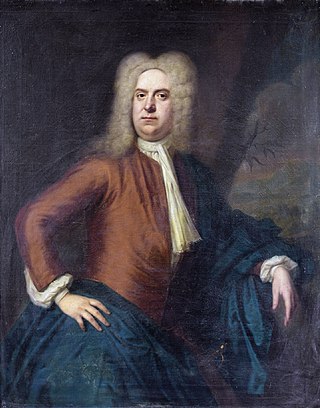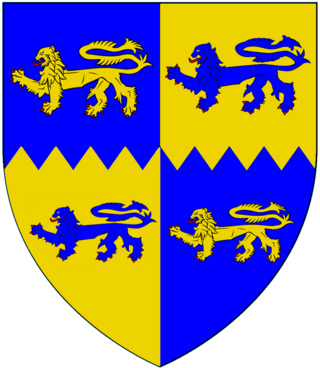Related Research Articles

Baron Rossmore, of Monaghan in the County of Monaghan, is a title in the Peerage of Ireland. It was created in 1796 for the soldier Robert Cuninghame, with remainder to his wife Elizabeth's nephews Henry Alexander Jones and Warner William Westenra, son of Henry Westenra and Harriet Murray, youngest sister of Elizabeth. Cuninghame was a General in the Army and served as Commander-in-Chief of Ireland. From January to August 1801 he also sat in the House of Lords as an Irish representative peer.

Earl of Dartrey, of Dartrey in the County of Monaghan, was a title in the Peerage of the United Kingdom. It was created in July 1866 for The 3rd Baron Cremorne.
This is a list of people who have served as Lord Lieutenant of County Monaghan.
County Monaghan is a former parliamentary constituency in Ireland, returning two Members of Parliament (MPs) to the House of Commons of the Parliament of the United Kingdom.

Lord Blayney, Baron of Monaghan, in the County of Monaghan, was a title in the Peerage of Ireland. It was created in 1621 for the soldier Sir Edward Blayney. He was succeeded by his son, the second Baron. He was killed at the Battle of Benburb in 1646. His younger son, the fourth Baron, represented County Monaghan in the Irish House of Commons. His elder son, the fifth Baron, was attainted by the Parliament of James II for supporting William of Orange. He had no sons and was succeeded by his younger brother, the sixth Baron. He was Governor of County Monaghan. His son, the seventh Baron, was Lord Lieutenant of County Monaghan. He was succeeded by his elder son, the eighth Baron. He was a clergyman and served as Dean of Killaloe. He had no surviving children and was succeeded by his younger brother, the ninth Baron. He was a Lieutenant-General in the Army. His younger son, the eleventh Baron, was also a Lieutenant-General in the Army and fought in the Peninsular War. Lord Blayney also represented the rotten borough of Old Sarum in Parliament. His son, the twelfth Baron, sat as Conservative Member of Parliament for County Monaghan and was later an Irish representative peer from 1841 until his death. On his death in 1874 the title became extinct.
The High Sheriff of Monaghan was the British monarch's representative in County Monaghan, a territory known as his bailiwick. Selected from three nominated people, he held his office for the duration of a year. He had judicial, ceremonial and administrative functions and executed High Court Writs.

Thomas Taylour, 1st Earl of Bective, KP, PC (Ire) was an Irish peer and politician.
William Caulfeild, 1st Viscount Charlemont PC (Ire), was an Irish politician and peer.
John Gore, 1st Baron Annaly PC (Ire) was an Irish politician and peer.
Christopher Plunket, 2nd Earl of Fingall and 11th Baron Killeen was an Irish politician and soldier. In 1641 he negotiated with the rebels on behalf of the Old English of the Pale and pushed them to join the rebellion. He fought for the rebels at the siege of Drogheda. He joined the Confederates and fought in their Leinster army, notably at Dungan's Hill. When the Confederates fused into the Royalist Alliance, he fought under James Butler, 1st Duke of Ormond in the Battle of Rathmines where he was wounded and taken prisoner. He died of his wounds two weeks later in captivity at Dublin Castle.

Cadwallader Davis Blayney, 12th Baron Blayney, styled The Honourable from birth until 1834, was an Irish nobleman and politician.
Sir Richard Bulkeley, 2nd Baronet FRS was an Irish politician and baronet.

Thomas Southwell, 1st Baron Southwell PC (Ire), known as Sir Thomas Southwell, 2nd Baronet from 1681 to 1717, was an Irish peer and politician.
Thomas Southwell, 2nd Baron Southwell PC (Ire), FRS, styled The Honourable from 1717 until 1720, was an Irish peer, politician and freemason.
Sir Alexander Cairnes, 1st Baronet was an Irish politician and banker.
Sir Tristram Beresford, 1st Baronet was an Anglo-Irish soldier and politician. He was the ancestor of the Marquesses of Waterford, the Barons Decies and the Beresford baronets, of William Beresford, 1st Viscount Beresford and Charles Beresford, 1st Baron Beresford.
Richard Wingfield, 1st Viscount Powerscourt, PC was an English-born army officer and military administrator during the reigns of Elizabeth I and James I. He is notable for his defeat of Sir Cahir O'Doherty's forces at the 1608 Battle of Kilmacrennan during O'Doherty's Rebellion in Ireland.
The Fenton Baronetcy, of Mitchelstown in the County of Cork, was a title in the Baronetage of Ireland. It was created on 22 July 1661 for Maurice Fenton. The baronetcy became extinct on 17 March 1670, with the death of his son William Fenton.

Edward Cromwell, 3rd Baron Cromwell was an English peer. He was the son of Henry Cromwell, 2nd Baron Cromwell by his wife Mary, daughter of John Paulet, 2nd Marquess of Winchester and his first wife Elizabeth Willoughby. His grandfather, Gregory, son of Thomas Cromwell, chief minister to Henry VIII, was created Baron Cromwell on 18 December 1540.
Rt. Hon. Henry Blayney, 2nd Baron Blayney, Baron of Monaghan was the son of Edward Blayney, 1st Baron, and of Ann Loftus his wife, daughter of Adam Loftus, Archbishop of Dublin and sometime Lord Chancellor of Ireland, by his wife Jane Purdon.
References
- ↑ Lodge, Edmund (1832). The Genealogy of the Existing British Peerage. London: Saunders and Otley. p. 43.
- ↑ Lodge, John (1754). The Peerage of Ireland, Or, A Genealogical History of the Present Nobility of that Kingdom. London: William Johnston. p. 124.